Simon Hughes, chief data scientist at DHI, discusses the importance of high-quality semantic search and matching in the job market, particularly for dice.com. He emphasizes the challenges of language processing, such as synonymy and polysemy, and explores various vector representations and techniques for improving search accuracy using deep language models and embeddings. The document outlines methods for embedding models in search, approximate nearest neighbor search, and implementation details in search systems like Lucene and Elasticsearch.





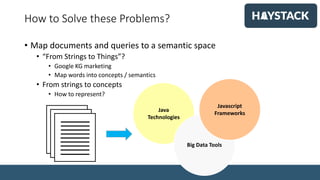



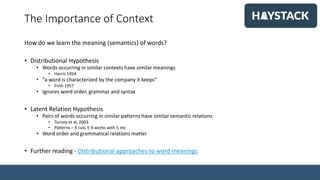

![Word2Vec
• By Aelu013 [CC BY-SA 4.0 (https://creativecommons.org/licenses/by-sa/4.0) ], from Wikimedia Commons](https://image.slidesharecdn.com/searchingwithvectors-190503182850/85/Searching-with-vectors-12-320.jpg)



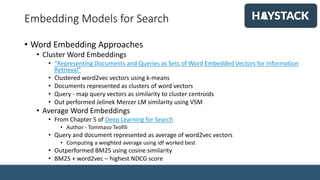


![Vectors in Search
• Dense Embedding Vector:
• Dense
• D dimensional
• D = 50-1000
• Inverted index:
• Sparse
• Pivoted by term
• V = Vocabulary
• |V| =100k+
• Fast because sparse
[+0.12, -0.34, -0.12, +0.27, +0.63]
Term Posting List
Java 1,5,100,102
.NET 2,4,600,605,1000
C# 2,88,105,800
SQL 130,433,648,899,1200
Html 1,2,10,30,55,202,252,30,598,](https://image.slidesharecdn.com/searchingwithvectors-190503182850/85/Searching-with-vectors-19-320.jpg)



![Zipf’s Law
• The frequency of terms in a
corpus follow a power law
distribution
• Small number of tokens are
very common - filter out
irrelevant docs
• A large number of tokens
are very rare - discriminate
between similar matches
• Distribution of last names - By Thekohser [CC BY-SA 3.0
(https://creativecommons.org/licenses/by-sa/3.0 )], from Wikimedia Commons](https://image.slidesharecdn.com/searchingwithvectors-190503182850/85/Searching-with-vectors-23-320.jpg)



![Encoding LSH Hash into the Index
• Hash into Bits
• Store hash fingerprint as a single token • Store each bit as a token using it’s position and value
• Use mm parameter to speed up search
• Or store shingles of the binary tokens
• This is not sparse!
[+0.08, -0.16, -0.12, +0.27, +0.63, -0.01, +0.16, -0.48]
[1, 0, 1, 1, 0, 1, 1, 0, 1, 0, 0, 1, 0, 1]
[“10110110100101”] ["00_1","01_0","02_1","04_1","04_0","05_1","06_1","07_0","08_1","09_0","10_0","11_1","12_0","13_1”]
OR](https://image.slidesharecdn.com/searchingwithvectors-190503182850/85/Searching-with-vectors-27-320.jpg)

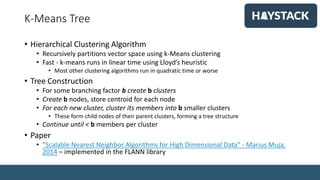





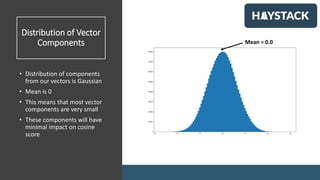
![Vector Thresholding with Tokenization
[+0.08, -0.16, -0.12, +0.27, +0.63, -0.01, +0.16, -0.48]
[ 0, 0, 0, 0, +0.63, 0, 0, -0.48]
• Drop all but the largest components
[“04i+0.6”, “07i-0.5”]
• Round weight to lower precision
• Encode position and weight as a single token
• Paper: “Semantic Vector Encoding and Similarity Search Using Fulltext Search Engines”](https://image.slidesharecdn.com/searchingwithvectors-190503182850/85/Searching-with-vectors-36-320.jpg)
![Vector Thresholding with Payloads
[+0.08, -0.16, -0.12, +0.27, +0.63, -0.01, +0.16, -0.48]
[ 0, 0, 0, 0, +0.63, 0, 0, -0.48]
• Drop all but the largest components
• I modified the previous idea, using payload score queries
• Indexing: Store remaining (non zero) tokens in index with payloads
• Querying: Uses custom payload query parser + similarity class
• See Github repo, and solr config in Kmeans tree section
Q=vector:(”3”^-0.0136 ”14”^0.05387 ”56”^-0.070476 ”71”^0.14529 …)
&defType=payloadEdismax](https://image.slidesharecdn.com/searchingwithvectors-190503182850/85/Searching-with-vectors-37-320.jpg)





